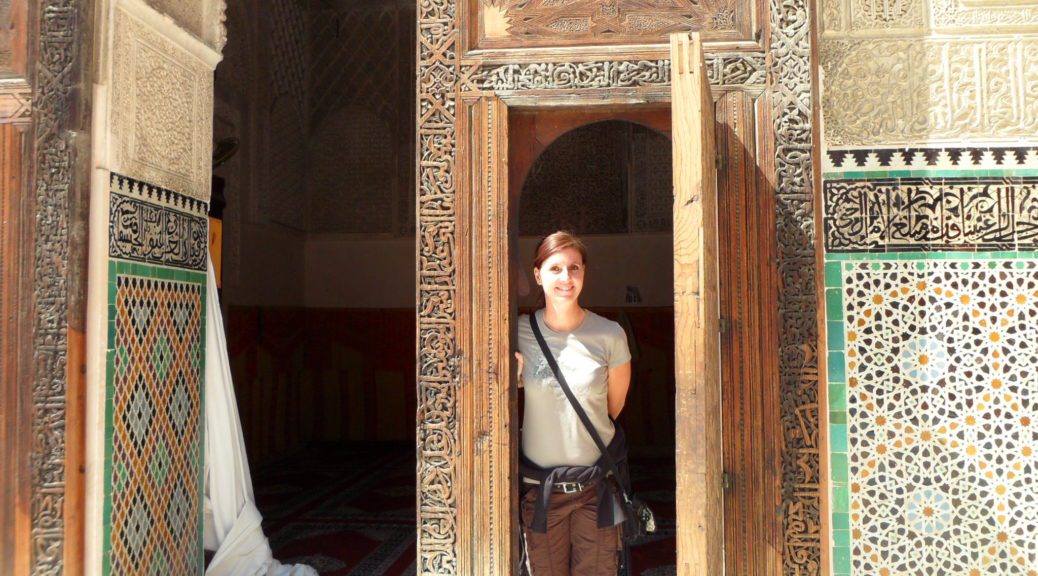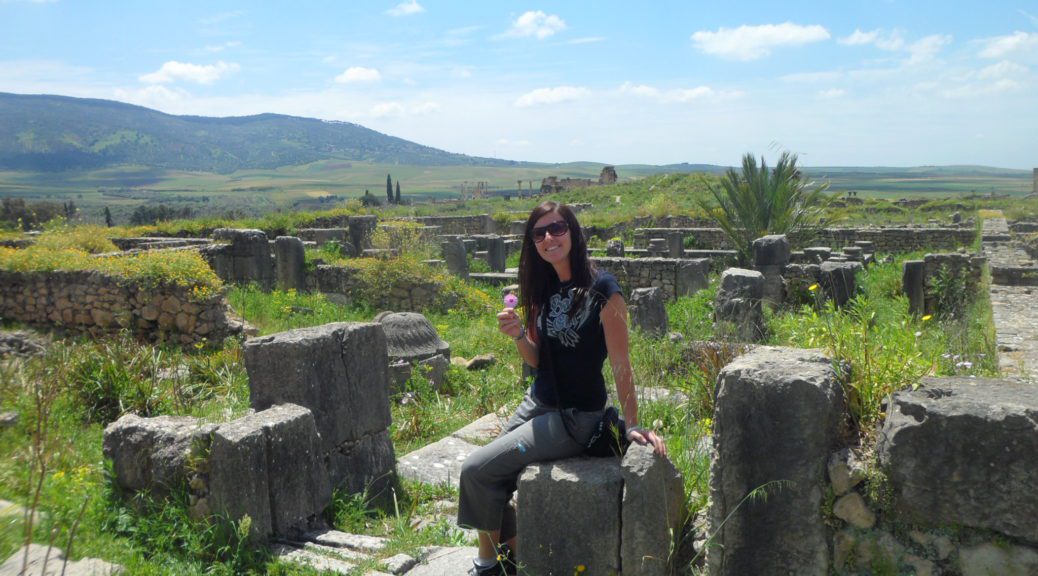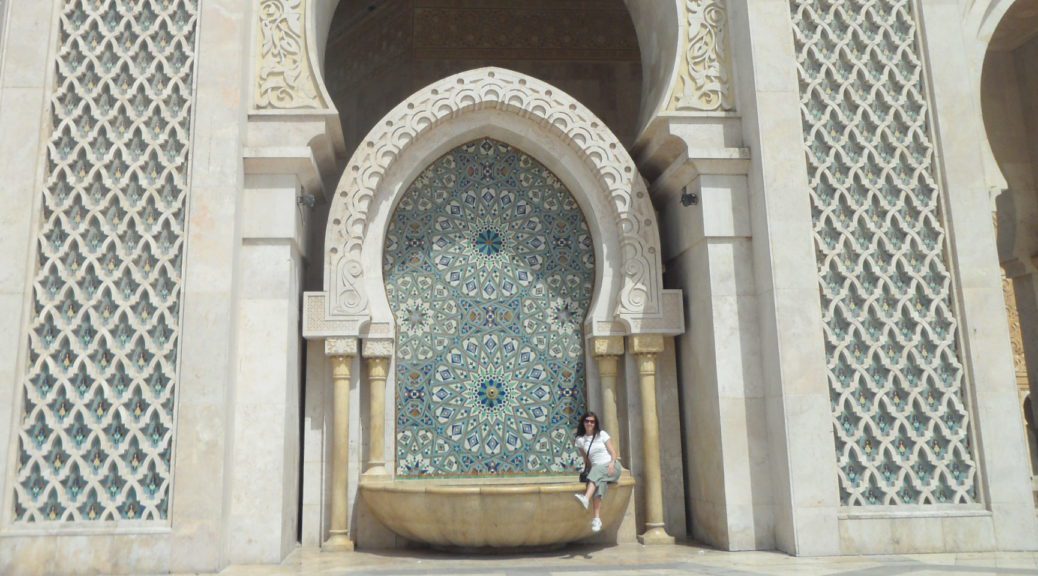MARRAKECH
24-26 April 2013
With 489km to cover from Fes to Marrakech, we had to be up and out early, hitting the road at 07h20. Breakfast was the same disappointing affair as the previous day – boiled eggs and chocolate croissant (separately), brightened only by the superlative OJ (very sour and authentic, but not pulpy) and excellent hot chocolate (made entirely with hot milk).
Since we have a full sized bus for just 17 people, there is more than enough room for everyone to stretch out, so it wasn’t too bad for the long haul. Quite soon most people were napping, so it was quite peaceful to watch the countryside pass by.
For a country of 35-odd million people, I’m not sure where everybody is. You can go for miles and miles without seeing sign of a human. Or animal for that matter. And Fes being one of the biggest cities at 1,5 million people seems to end too soon after city centre for credibility (although at least we did see more of what we consider traditional Morrocan architecture, which provided a level of smug contentedness).
The “highway” was by no means what we’re used to and very picturesque. Although predominantly single lane either side, the allocations are generous – and everyone seemed to crawl evenly so we weren’t ever stuck wanting to overtake. The tarring was consistently perfect and they (the French I presume) were meticulous to the point of obsession with lining the road with double rows of trees either side. We were told that most were cedars, which were protected (probably because of the obscene amounts they use for those gargantuan doors and gates).
It was remarkable to see how well established and maintained the infrastructure was even in the smallest towns. Double lanes standard in city centres (not a whiff of a pothole); wide pavements tiled with elegant and decorative paving stones with neat and generous flower and tree gardens embedded; at least 1 showy traffic circle with manicured gardens, fountains and/or statues even in the smallest town; clear of litter and debris, with the odd street-sweeper spotted sweeping the gutters like life depended on it. It was like the Moroccans are better at being European than the Europeans! … Except for the Arabic on the street signs and a disproportionate representation of green roof tiles (apparently a tribute being a well-associated Muslim colour).
Our first pitstop was in the University and ski resort town of Ilfane. It was a private and pricey university, twinned with Georgetown University in Washington. The town was nestled into one of the Middle Atlas Mountain slopes and besides being renowned for skiing (getting snow up to 1m deep in town), it was also known as the Little Switzerland of Morocco, having been built by the French in the 1930s with A-frame chalets and beautiful little cabins. It was gorgeous – and certainly worth an investigation for a cheap ski holiday!
We rolled into Marrakech at about 18h30 and checked into our hotel – a luxurious resort with gorgeous lobby with marble floors and enormous chandelier suspended from a triple volume section in the centre that hinted at the floors above. Automated doors led to a generous terrace with wonderfully extravagant swimming pools, welcome in the hotter drier climate than that from which we’d just come.
We had an hour before dinner to check in and make ourselves comfortable in our rooms, which turned out to be superb – and a welcome break from our bus!
The hotel dinner was excellent, including mash potatoes (my best!), roast turkey in lemon and herb gravy, a beef goulash type dish (Moroccan-style of course) and incredible creme caramel for dessert. Of course, the buffet offered far more than that, but it was these few simplicities that hit the spot and sated.
We’d planned to catch the 20h30 hotel shuttle to the famed Marrakech souk, but were dismayed when the bus filled before our eyes and the 4 of us were left standing on the pavement watching a busful of people disappear toward town!
Luckily, we’re not easily disheartened and we simply flagged down a taxi and negotiated a R50 return fare – and ended up regretting bothering with the shuttle at all, when our own steam was so convenient, cheap and easy. We agreed for the taxi driver to meet us at the designated spot (a KFC, definitely to be revisited for mealtime purposes later!) and hit the market with much excitement.
The market was chaos! Starting with the main square, with loads of entertainment, snake-charmers, drum circles and so on, there were literally thousands of people wandering around, soaking in the atmosphere. There was no way that the 4 of us would manage to maneuver together through the crowds in the dark, so we split up to shop. In the 6 square kilometres of shopping area on offer!
Mother and I picked an aisle and immersed. It was quite overwhelming so we decided to set the pace, researching and price-comparing in order to be ready for real action and quality purchasing the next day. Mother also did her fair share of Cinderella’ing, trying on every pair of bright yellow slippers she could get her hands (well, feet) on… And getting more and more depressed as each one was either too big or too small (or not yellow enough).
Time passed all too quickly and we were soon communed at the KFC, fruitless shopping trip behind us, but optimism that our prudence would stand us in good stead the next day. And optimism that our great hotel dinner might be a prelude to a great breakfast buffet.
Sadly, breakfast was far from greatness. While there was a revival with scrambled eggs and they added a pancake station, there was no french bread to make Vietnam sandwiches with – and still no bacon or bangers! Now very sorely missed!
Still, we were fed and watered and ready to go on the city tour when the coach arrived to fetch us. The tour started with the Mosque (of course) and Koutoubia minoret. All the Moroccan minorets are square, as is this one with its 3 x 18 carat balls of descending sizes on a spire atop the dome, and a 1kg ball of solid gold to top it all off.
The opulence continued at the Bab Agnar Gates, the most beautiful of the gates with cut stone arranged in clean, regular lines around the arch, floral decorations and calligraphy adorning the cornerstone and frame panels. This gate was famed for where the Berbers brought their fruit liquor (40% proof) down from the mountains to sell in the medina.
Then into the kasbah (fortress) and on to the royal residence. A maudlin visit to the Saadian mausoleum for 16th century rulers. Traditionally, the dead weren’t embalmed, and were buried lying on their side facing Mecca. As was customary, they would always separate kings, princes and queens, burying important people in the centre quad.
We entered the Bahia Palais, which became a tourist sight in 1956 alongside Moroccan Independence (you can only see about a quarter of it though, because the king still uses the suites when he’s in town). The palace took 17 years to build – 1893 to 1900 – and was reserved for the first of the 4 official wives to bear a son. He also had 24 concubines (bought or given as gifts, aged 13-14 years old who at 35 become cleaners) to complete the harem. The palace covers 8 hectares, 4 of riad and 4 of rooms and buildings, all with tiles in natural mineral or vegetable colours. The walls are incredibly thick and other measures have been taken (like doors within doors) to insulate from searing summer heat and freezing winters.
We wound around, being shown this and that, including the leather works and steelworks (where business is largely conducted as in olden times – and the welders don’t cover their eyes and wear flipflops!) – and being taken into what we suspect are the ‘kickback’ stores, where guides get commission on sales generated from the guests they bring in. The most interesting of these was the pharmacy/spice shop combo, where they tried to flog us (over-priced) everything from “35 spice” to cumin to arnica to Argan oil to mint tea. Of course, Mother wasn’t falling for that and “went to the loo”, returning with a gorgeous big leather overnight bag! She’d snuck out and down the road to haggle a bargain with the leather man! 😀
Can’t really blame her. Knowing the El-Jamaal Fna Souks cover 6 square kilometres of shopping, means that if you miss the opportunity to buy there and then, you may very well not be able to find your way back to that store. We’d learned this the hard way at the Grand Bazaar in Istanbul the previous year! …And we were quite committed to committing when it came to the day’s shopping. We methodically ticked off the items on the list that we’d plotted and planned over the duration of the trip, added some new ones and bargained and bought like we were on a trolley dash!
Still, we seemed to be out-shopped by Monique (a short plump half of a middle-aged couple) from Brussels, who didn’t seem able to resist any peddler who walked up to her (and there were many since she didn’t bargain). We laughed when we met back at the bus and there was Monique with a Moroccan cotton shirt (not even close to her size) slung on her back, 2 mens leather belts fastened around the waist, bangles up to her elbow, bulging shopping bags clutched in her henna’ed hands, husband in newly acquired silly hat in tow.
There was an hour to freshen up and then it was back in the bus and off to the Fantasia cultural evening. We ended up sitting with our Saffa friends and the Canadian couple from Ontario; much easier company than the Lebanese and Belgian couples we’d shared the awkward lunch with en route to Rabat.
Dinner was a bit weird. Started with soup, plated at the table. Seemed to be what I’ve seen (imaginatively) described as “Moroccan”, ie a hearty consistency with barley, chickpeas and veg. Not quite sure if it had meat or not. As has become customary, we asked for butter or olive oil to have with our bread. As is customary, they said they’d get it and never did. They don’t do ice either, which is annoying. It’s so sub-grade drinking Coca-Cola – or wine for that matter – without ice. It’s really the simple things that make you appreciate home!
The next course was even more odd, because it was so unexpected. The waitress delivered a platter with half a sheep on it. Literally. We got the entire right side of a sheep between the 6 of us! Just plopped on the table without instruction, carving utensils or any sort of accompaniment. No garnish, starch or veg! We hacked at the poor beast, each serving ourselves using our own knives and forks. Such a pity, because so much must have been wasted – and it was very tasty.
If we thought it was odd, the Canadians were horrified. They *really* didn’t know how to operate this course. The wife picked a bit at their end of the sheep and was visibly unimpressed. When asked, they said the lamb was a bit dry and, seeing as our end was very succulent, I suggested she try the shank. She didn’t know what it was, so I told her it was the bit that looks like a drumstick. She pulled on the leg bone, which came out clean (the lamb was that tender!) and she placed it gingerly on her plate, looking at it puzzled as to why I’d suggest it. Glad to clarify that I really meant the knob of meat around the top of the bone, it was very rewarding to see how much they enjoyed the meat when they eventually recovered it. It all made better sense later when the couple told us they’d met when they worked at McDonald’s…
When the table was cleared, another server delivered the next course. Chicken and veg with couscous. Another mountain of food! It was a bit dry so we made a plan and nabbed an extra bowl of the hearty soup to use as gravy. An excellent plan!
Dessert was (yet another) bowl of fruit. Just fruit. Costa chopped up and apple, which we passed around. I did the same with an orange. There seems to be no middle ground in Morocco – either obscene amounts of baked goods or dull and boring whole fruits. These people really need to embrace an elegant simplicity like ice-cream and chocolate sauce!
The whole way through dinner, we had entertainment brought to us. Groups of musicians and dancers from the various Moroccan tribes. They have a very different idea of tempo and rhythm to ours, to be sure! We specifically enjoyed an odd little hand-flicking dance that the first lot did, which looked like they were trying to dry a fresh manicure. It was also unusual that their “dancers” clearly weren’t recruited based on looks or age, nor were they the usual scantily clad belly-dancer types but rather draped in quite excessive layers of cloth and carrying a tune seemed optional for their “singers”.
The beat was carried by handheld drums and/or tambourines and one tiny wrinkled old tambourinist seemed to take a shine to Mother, doing a bizarre Arrested Development chicken dance, alternating banging the tambourine in her ear and leering and jeering at her with contorted facial expression. By the time the group moved on (with Chicken Dancer continuously turning back and throwing parting shots in our direction), Jolande, Diane and I had tears streaming down our face from laughter! Such a pity that their partners had missed all the fun, having pleaded “smoke break” (despite neither being smokers) as the troupe approached, tired from being cajoled into getting up and dancing with the entertainers. Might have been a different story if they had been the slinky sexy belly-dancers! 😉
After dinner, we moved to sit on the concrete grandstands facing the centre quad to watch the belly-dancing show (in the conventional sense and outfit) and horse displays. The equestrian elements were divided into 2 types, the traditional warlike charging and tricks and balancing acts by skilled horseman on horseback; dismounting and remounting, running alongside and remounting and twisting and slipping around the horse like it was a gymnastics prop! The charging was a bit more disturbing, with the riders in flowing robes and turbans, frothing the horses up to quite a pace and then skidding on the brakes and shooting their rifles in the air (crackers not bullets). The real thing must’ve been quite fearsome… But it can’t be fun for those horses having to endure that every night.
All the entertainers came out and paraded around the field a bit in a sort of closing ceremony and then the night was called a close and the bus took us back to the hotel.
Having a later night than we have been, it was nice to have no plans for the morning so we could sleep in. We met our Saffas at 9 for breakfast and were ready well in time for the 10 o’clock shuttle into the market for a last whip around.
We didn’t buy (much) and the highlight was ending off with the much-craved KFC. I tried the Big Filler, which is chicken strips with cheese, ham (surprisingly; first pork we’ve seen in Morocco), garnish and ranch dressing. Served with McD’s style chips and Mirinda… met ys! Very delicious!
A shuttle back to the hotel and we’re packed and ready to move out. Back to Casablanca in the arvie and then homeward bound on our last day!



